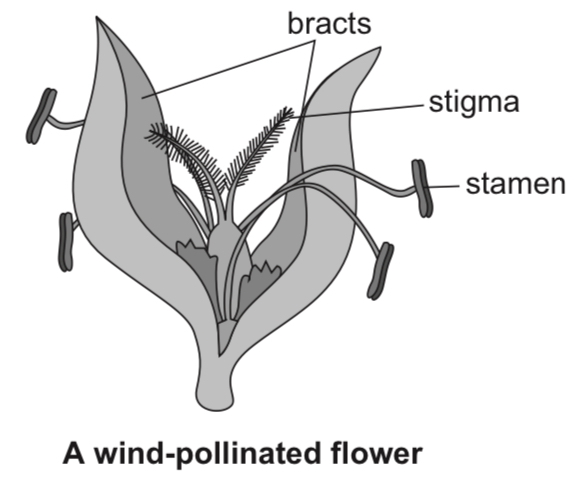Chapter 20 - Reproduction in Plants
Introduction
Reproduction is the biological process by which new organisms are produced to ensure the perpetuation of the species.
Reproductive methods are grouped into two main groups: asexual reproduction and sexual reproduction.
Asexual reproduction is when an organism produces a genetically identical offspring without the contribution of genetic material from another organism.
Sexual reproduction is when a genetically dissimilar offspring is produced through the fusion of two gametes, one from each parent organism, during the process of fertilisation.
Gametes are reproductive cells that contain half the number of chromosomes as a normal body cell.
The zygote produced during fertilisation contains genetic material from both parents, and is therefore genetically different from them.


Difference between wind and insect pollinated flowers:

Pollination
Pollination is the transfer of pollen grains from the anther to the stigma, enabling fertilisation.
Mechanisms of pollination include insect pollination and wind pollination.
Insect-pollinated flowers contain nectar and have nectar guides which are lines that are visible to insects, guiding them to the location of the nectar.
When the insect enters the flower, pollen grains from the anthers stick onto the insect. If pollen grains from a previously-visited flower are present on the insect, they will be transferred to the sticky stigma.
Wind-pollinated flowers have their pollen carried away by the wind when the exposed anthers shake in the wind.
When the pollen grains come into contact with the large feathery stigmas of another flower, they would be trapped.
There are two types of pollination: self-pollination and cross-pollination.
Self-pollination
Self-pollination is the transfer of pollen grains from the anther to the stigma of the same flower, or from the anther of a flower to the stigma of another flower on the same plant.
Factors that promote self-pollination are:
(a) Bisexual flowers with anthers and stigma maturing at the same time.
(b) Stigma being located directly below the anthers, allowing pollen grains to fall onto it.
Advantages of self-pollination are: (a) Not dependent on external agents of pollination such as insects or wind.
(b) Less wastage of pollen and energy. During wind and insect pollination, a great number of pollen grains are lost as only a few pollen grains come into contact with a stigma of a flower of the same species.
(c) Only one parent plant is required.
A disadvantage of self-pollination is less genetic variation, hence the offspring is less adapted to environmental changes.
Cross-pollination
Cross-pollination is the transfer of pollen grains from the anther of a flower to the stigma of a flower of another plant belonging to the same species.
Factors that promote cross-pollination are: (a) Plants bearing only male or female flowers. These plants are called dioecious plants. (b) In plants with bisexual flowers, the anthers and the stigmas mature at different times. (c) Self-incompatibility – When a pollen grain of a flower happens to land on the stigma of the same flower or another flower on the same plant, a biochemical block prevents the pollen grain from germinating.
Advantages of cross-pollination are: (a) Greater genetic variation, hence the offspring has a higher chance of surviving environmental changes. (b) Offspring may have inherited beneficial qualities from both parents.
Disadvantages of cross-pollination are: (a) Energy-consuming – lots of energy is required to make large amounts of pollen grains. (b) A great number of pollen grains are wasted due to the randomness of the dispersal methods. (c) External agents of pollination i.e. wind, insects are required.
(d) Two parent plants are required.
Double fertilization in plants:

After pollination, a pollen tube grows out of each pollen grain in response to the sugary fluid secreted by the stigma.
The cytoplasm and the two nuclei of the pollen grain (generative nucleus and pollen ‘tube nucleus) pass into the pollen tube. The pollen tube nucleus controls the growth of the pollen tube.
The pollen tube grows through the cells of the style by secreting enzymes to digest them.
The generative %%nucleus divides %%to form two male gametes.
The pollen tube enters the ovary and then enters the ovule through an opening in the ovule wall called a micropyle and releases the two male gametes.
One male gamete fuses with the ovum to form the zygote. The other male gamete fuses with the definitive nucleus to form the endosperm nucleus.
The zygote will divide and develop into the embryo. The endosperm nucleus will divide and give rise to the endosperm, a food storage tissue that will nourish the developing embryo.
The ovule will develop into a seed and the ovary will develop into a fruit.
 Knowt
Knowt
